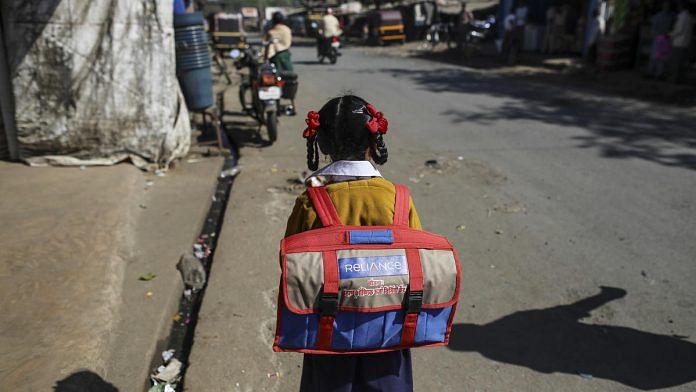New Delhi: National capital Delhi is among five states/Union Territories that have been called out by the central government for “constantly faltering” on sex ratio at birth (SRB). The other four are Bihar, Karnataka, Odisha and Uttarakhand.
Meanwhile, Rajasthan and Haryana, which are among the states/UTs with the lowest SRB, have been lauded for registering an improvement on the parameter.
The SRB, measured as the number of females born per 1,000 male births, is a yardstick to assess gender-biased sex selection in a certain region or country.
In a letter to all states and Union Territories earlier this month, the secretaries of the Union ministries of women and child development (WCD), and health, have asked the five states/UTs to undertake necessary steps to check the problem.
“As we are aware, the continuous decline in the child sex ratio (CSR) indicating gender discrimination needs attention and focused intervention towards creating an enabling environment for the girl child,” the letter states, citing the Sample Registration System (SRS) Statistical Report 2018 published by the Registrar General of India (RGI), made public last year.
“It concerns us that the same report records a decline in SRB (sex ratio at birth) in seven states with maximum decline in Delhi by 6 points followed by Odisha, Karnataka, Bihar by 5 points, Chhattisgarh by 3 points, and Maharashtra & Uttarakhand by 1 point.”
Delhi, Bihar, Karnataka, Odisha and Uttarakhand, it adds, “are constantly faltering on SRB and have recorded decline since 2014-16”.
According the SRS statistical report, sex ratio at birth in India declined marginally to 899 in 2018, from 906 in 2011. The fall was the worst in Delhi, where the SRB declined to 844 in 2016-2018, from 876 in 2012-14. It was 869 in 2013-15, 857 in 2014-16, and 850 in 2015-17.
“It is requested that the states that are lagging, need to strengthen their efforts with additional result-oriented initiatives and address the issue of declining sex ratio at birth as well as the issues concerning the implementation of the PC&PNDT Act (Pre-Conception and Pre-Natal Diagnostic Techniques Act, 1994),” the letter adds.
The Act, which outlaws sex selection, was brought to stabilise India’s sex ratio that has suffered on account of a long-held societal preference for the male child.
The central government has recommended birth registration campaigns at the panchayat level to ensure 100 per cent birth registration, and geo-tagging of all sonography machines to detect malpractices under the PC&PNDT Act.
“Accordingly, states are urged to review their strategies in this direction and work according to a comprehensive action-oriented plan,” the letter adds.
Also Read: Haryana’s worst sex-ratio offenders are welcoming the girl child, and everyone is invited
The states/UTs that have been lauded
In the same letter, the ministry has lauded Rajasthan, Himachal Pradesh, Gujarat, Haryana, Assam and Jammu and Kashmir, among other states/UTs, for registering an improvement on SRB.
Speaking to ThePrint, a WCD official familiar with the communication said the “latest report of the RGI threw up a complex picture where some of the states, which are traditionally known to perform badly when it comes to CSR, like Rajasthan and Haryana, have improved, but there is a decline in states/UTs like Delhi, Karnataka, Maharashtra”.
“The Centre has sought to remind these states that the CSR cannot be allowed to fall, and sustained campaigns and detection of illegal activity needs to be carried out,” the official added.
Fifteen of 22 states/UTs surveyed for the SRS statistical report have shown an improvement on the parameter, with the maximum improvement of 15 points recorded in Rajasthan, followed by Himachal Pradesh (12 points), Gujarat (11 points), and Haryana, Assam and J&K (10 points each).
Why the fall in SRB in some states/UTs?
One of the reasons behind the declining SRB in some states is a fall in fertility rate, the official said. Fertility rate is defined as the number of children women have on average during their childbearing years.
“Because people are having fewer children, fertility rates are declining, and their preference remains a boy,” the WCD official said. “The states need to step up their detection efforts to see where sex selection is happening.”
In a 2014 paper, Seema Jayachandran, an economist at the Northwestern University, Illinois, had also argued that declining fertility rates were linked to worsening sex ratio in India.
“The smaller the family size, the less likely a family is to have a son by chance. Thus, declining fertility is one force that is driving up the rate of sex-selective abortions,” she had written.
Also Read: Too soon to celebrate Modi govt’s sex ratio claim, wait for 2021 census, say experts




Sikhs and Jatts can go any length to get a male progeny. That is why Punjab and Haryana have the worst sex ratio.